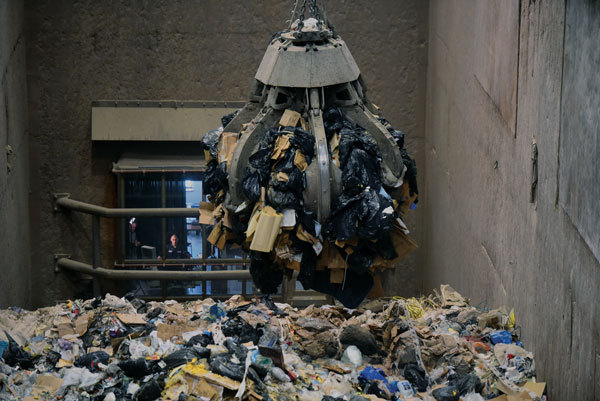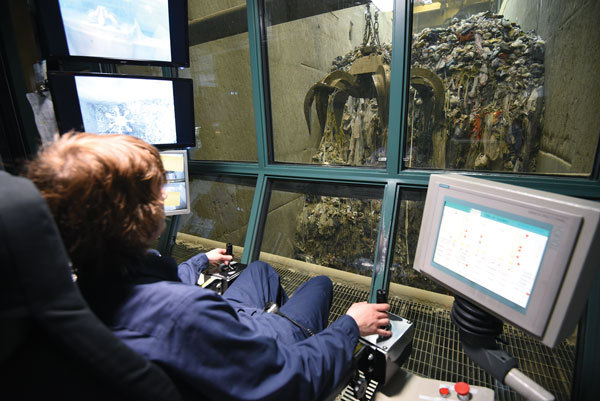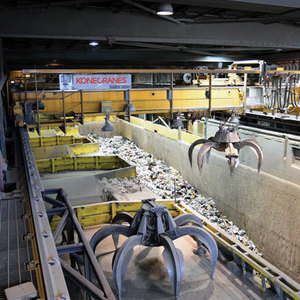Out With the Old










PHOTO: LINDA GRAHAM
April 25, 2016
BY Linda Graham
North American energy-from-waste (EFW) facilities are at a crossroads. Built 20 to 40 years ago, most are operating with cranes that may be at or nearing the end of their service life. The question these facilities face today is how to replace or modernize their aging cranes without disrupting service to customers or the revenue stream from the energy they produce.
When the city of Quebec, Canada, built its EFW plant in North America in 1974, the facility was designed to incinerate Quebec’s municipal garbage at the rate of 280,000 tons per year and generate a $10 million annual income by selling steam to a nearby pulp and paper plant.
Fast-forward to 2006. The primary tools of any EFW plant are its overhead cranes, and Quebec’s two aging cranes were costing the city more than $400,000 per year to maintain. Designed before modern technologies such as load sway prevention were available, the cranes were difficult to operate and hard to keep running. Critical components such as wire ropes were wearing out every two weeks, structural failure was rampant and downtime was escalating. And when the cranes were down for repair, the facility was unable to receive, mix or burn waste.
According to Konecranes’ Joseph Botros, Quebec’s problems were not unique–they are shared by many older EFW plants in North America. “The growing focus in the industry is on these older facilities–and how they intend to move forward for the next quarter century,” says Botros, Konecranes’ director for EFW, Americas and Asia-Pacific Regions. “Their biggest concern is how to replace or modernize the cranes without interrupting production.”
Fortunately, there are solutions. In both Europe and North America, Konecranes has demonstrated its ability. As the City of Quebec has discovered, the right cranes from the right supplier can actually pay for themselves over time.
Yves Frechet, Quebec’s principal design engineer, has been involved with Quebec’s EFW facility since 1991 and was instrumental in guiding the renovation process. “Our original cranes experienced 2 million cycles over their lifespan, and operators who needed to work quickly sometimes treated them roughly,” he says. “The fatigue of the cranes was understandable, but it was a major problem for productivity.”
In addition, cranes operating without sway control were constantly colliding with the pit walls, damaging both the building and the structural integrity of the cranes themselves.
“The entire building was stressed from the movement of the cranes, and there was a lot of reparation needed on the structure,” Frechet sats. “We had to repair the concrete pit walls repeatedly because the swinging grab damaged them. It was a big problem for us, getting worse year after year.”
The old cranes had some rudimentary automation, an in-house retrofit by one of the facility’s employees. One of the cranes would receive a signal that it was time to feed the hopper, and it would pick up a load of garbage and deliver it to the hopper for burning. While not a perfect solution, it got the job done. But for the renovation, Quebec wanted state-of-the-art, automated cranes that were integrated with their entire facility—technology with more to offer in terms of information and feedback, plus strategies to reduce maintenance and prolong the life of the facility and its equipment. Frechet contacted crane automation company Konecranes in 2006 to talk about redesigning the lifting interface for the whole facility.
More With Modern Cranes
According to Botros, the solution involved much more than two new cranes. It was a turnkey project that involved modernizing, automating and rewiring virtually the entire facility and redesigning it for maximum efficiency and productivity. Quebec’s new, automated cranes do far more than their older counterparts. They manage waste reception, feeding and mixing to make it burn well.
Quebec’s crane and automation package was based on Konecrane’s technology that had been developed for and delivered successfully to several EFW facilities in Europe. Konecranes specified two new fully automated CMAA Class F AC-powered cranes with variable frequency drives for energy efficiency and an easier-to-operate hydraulic grab. The cranes are identical, 10-metric ton capacity with 2.5-ton auxiliary hoists, operating on a 55-meter runway. Each crane is equipped with a hydraulic grab that picks up more than twice the amount of garbage as the previous cable-operated mechanical grabs, and also has the ability to compress the garbage to hold more.
When it comes to safety and ease of operation, the difference is palpable. “The new cranes have a very soft start, accelerating and decelerating gradually, with no shock to the structure of the building,” says Frechet. Konecranes DynAPilot anti-sway technology has also reduced wear and tear on the facility by preventing collisions of the grab with the pit walls. “Since we replaced the cranes that problem has stopped,” he says.
According to Frechet, the new cranes can operate manually, in semiautomated mode or in full automation, similar to a robot zone. “When we operate in automatic, nobody can enter the operation area, so it is extremely safe,” he says.
Automating the Tipping Process
The new cranes are able to “talk” to the plant’s DCS system, which is the managing software of the entire incinerator. Konecranes installed the cranes and all the wiring in the building, along with sensors that function as the “eyes” of the cranes. These laser sensors detect the garbage trucks as they arrive on a platform with eight bays. Through a system of traffic lights integrated with the crane’s automation, they direct the trucks where and when to dump garbage. Green indicates to drivers that dumping is permitted. Red lights signal drivers not to dump in a bay where a crane is active in the reception zone. “The truck operators respect the lights, and there is good collaboration with them—it is working very well,” Frechet says. “We have cameras to watch the truck operators and they know that they are being supervised, so they respect all the procedures,” he continues.
New Crane Installation in a Live Facility
Originally, the plant only had parking for one of its cranes, with the other always positioned over the pit, vulnerable in the case of fires. A major element of the redesign was the addition of a maintenance bay for the second crane. This new building feature made it possible for the first time to use the facility’s two cranes equally, extending the service life of both. But even more importantly, it allowed Konecranes to replace the cranes without shutting down production. “It was a major challenge for the facility,” Frechet says. “It was not possible to transfer the waste to a landfill—it was necessary for us to continue to incinerate the waste while changing out the cranes. We also had a client for the energy produced by incineration–the client was a paper mill near the incinerator. Our agreement required that we continue delivering steam to the mill without interruption. So we had to replace the cranes while operating the facility and continuing to deliver power,” he says.
Konecranes worked with Frechet to develop a strategy to replace the cranes one at a time. The city built the additional crane maintenance bay adjacent to the refuse pit, which enabled one crane to be parked out of the way and replaced while the other continued to operate.
As part of the renovation, the plant replaced all of the rails and support structures, and upgraded the structures to be compliant with new safety regulations. The new maintenance bay gave Konecranes a secure area to perform the installation. The company installed the first new crane, then removed the first old crane, which allowed the facility to operate with one new and old one crane. “After that, we installed the second new crane, and then we removed the second old crane, prior to putting on the roof of the building addition,” Frechet says. Konecranes installed both new cranes in a total of four weeks.
“We received and processed all the waste we needed to receive during that period,” Frechet says. “It was not our peak season for reception of waste–we did the job in November and December, and during those months, we receive the lowest amounts of waste for the year. We were able to receive all the waste the city sent to us and maintain complete operation of the plant during the crane replacement.”
Protecting Infrastructure
One important goal of the facility redesign and crane replacement was to better protect people and infrastructure while improving throughput. A key Konecranes technology known as “Protected Areas” is preprogrammed into the software controlling the cranes, to create no-go areas, as well as predetermined destinations for loads of waste. For Quebec, the operator’s cabin, water stations and access stairways are some of the areas that are off-limits for the crane’s grapple. Other elements of this feature facilitate positioning so that loads of garbage destined for the hopper end up inside the hopper, not next to it. The automation software actually prevents the crane from missing the hopper. “A grab can weigh somewhere between 2 and 8 [metric] tons, depending on its size and range,” says Botros. “To understand the magnitude of this issue, just imagine an 8-ton grab slamming into a concrete pit wall like a wrecking ball. Konecranes Protected Areas feature is designed to safeguard infrastructure. When the grab approaches an approved destination, it slows down and then stops, with no load sway that could damage the pit walls or other important structures.”
Paying For Themselves
After Quebec installed its new equipment, crane-related maintenance costs fell 80 percent from the $400,000 the facility spent on its original cranes in their last year of service. In the nine years since, the improvement in crane maintenance cost has continued at this level. The facility’s enhanced ability to perform scheduled crane maintenance without impacting throughput is another benefit of the new maintenance bay and is expected to help the city of Quebec keep its cranes in top shape for a long time.
In addition to the maintenance savings, electrical consumption of the new cranes is significantly less. The facility’s contract operator TIRU Canada logged a 12 percent drop in electrical consumption for the whole facility, immediately after the new cranes went online in 2008. “The old cranes were very heavy, and when you have something very heavy to move, it takes more energy,” Frechet says. Since 2012, Frechet has left the facility to develop a new anaerobic digestion plant to receive the Quebec’s organic waste. This $100 million project will create a product akin to natural gas that can be utilized in the city’s trucks and busses.
Frechet’s successor Vincent Pouliot, city of Quebec engineer, weighs in on the continuing cost savings attributed to the crane replacement and facility redesign. Pouliot related that as a result of the changes, Quebec’s contract EFW facility operator TIRU Canada has become more cost-effective. When the operator’s contract came up for renewal in 2008, TIRU was able to win the bid again with a tight, competitive proposal whose 16 percent reduction over their previous contract at least partially reflected how much the facility’s operating expenses had dropped. According to Pouliot, money formerly spent on maintaining the cranes now benefits other areas. “The cost savings was redirected to the other equipment, including the furnace, the boiler, the automation system and all the other equipment in the facility,” he says. “The crane replacement generated significant benefit to the facility as a whole, as they use that money to do maintenance on other parts of the process,” he says.
Enabling Better Manpower Utilization
Savings have also extended to personnel costs. Originally, a crew of five was required to operate the old cranes over three shifts, with two operators working each daytime shift and one at night. Now, the new cranes spend most of the time running in full automation at night, freeing up the operator to perform additional tasks. During the day, the cranes require only one operator per shift, which has allowed TIRU to move two employees to support other areas of the plant. Therefore, one direct benefit of installing modern, automated cranes is the annual cost of two skilled employees.
According to Pouliot, when the Quebec facility first began operating in 1976, it ran three furnaces burning 10 tons per hour. Today, it burns four furnaces in the summer, a 25 percent increase. Since Quebec’s crane operators also typically manage the furnaces, automating the cranes has provided the manpower to run the additional furnace and given the facility redundant skill sets for both areas. “This is good news for all EFW operators,” says Botros. “Many older EFW facilities are running barebones programs, so automating the cranes can enable them to redeploy manpower to other areas where they may be shorthanded. This helps the whole facility.”
Today, Quebec’s EFW facility is reaping the benefits of more efficient, automated technology and a safer workplace. Operational costs have dropped so much that, less than a decade after their installation, the cranes have already paid for themselves. The best news: The financial windfall generated by lower maintenance, electrical and personnel costs should continue to accrue for years on the city’s bottom line.
Frechet emphasizes how critical it was to work with a partner that had experience replacing existing cranes in a running facility. “The experience of the supplier was one of our principal requirements,” he says. “Reliability was another. It was very important for us that the cranes work, 24 hours a day, seven days per week, all year long. And, it continues to be important year after year.”
Author: Linda Graham
Wordsworth Ltd.
713-937-0043
For more information, click here.
Advertisement
Advertisement
Advertisement
Advertisement
Upcoming Events





